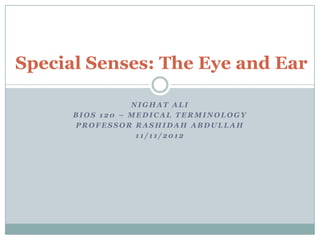
Special senses chapter 13
- 1. Special Senses: The Eye and Ear NIGHAT ALI BIOS 120 – MEDICAL TERMINOLOGY PROFESSOR RASHIDAH ABDULLAH 11/11/2012
- 2. The Eye The eye contains the sensory receptor cells for vision. The study of the eye is known as ophthalmology and an organ of sight that transmits an external image by way of the nervous system – the optic nerve – to the brain. Following abbreviations in section J are relative to the eye: EENT EM EOM OS VA XT
- 3. The Ear The study of the ear is referred to as otology and the study of hearing disorders is called audiology . The ear contains the sensory receptors for hearing and equilibrium. Hearing and equilibrium sensory information is carried to the brain by cranial nerve VIII – vestibulocochlear nerve. The cochlear nerve carries hearing information, and the vestibular nerve carries equilibrium information. Following abbreviations in section J are relative to the ear: EENT AU BC OM PE tube
- 4. PE tube – Pressure Equalizing Tube A small plastic or metal tube is placed within the tympanic membrane to equalize the pressure behind the eardrum and to allow for adequate drainage of any fluid within the middle ear space. PE tubes have been shown to decrease the frequency of ear infections while not compromising hearing function.
- 5. EENT – Eye, Ear, Nose, and Throat
- 6. BC – Bone Conduction Bone conduction is the conduction of sound to the inner ear through the b ones of the skull. Bone conduction is the reason why a person's voice sounds different to him/her when it is recorded and played back. Because the skull conducts lower frequencies better than air, people perceive their own voices to be lower and fuller than others do.
- 7. AU – Both Ears Latin meaning - auris utraque
- 8. OM – Otitis Media Inflammation of the middle ear, or middle ear infection. It occurs in the area between the ear drum (the end of the outer ear) and the inner ear, including a duct known as the eustachian tube. The inflammation often begins with infections that cause sore throat, cold or other respiratory problems, and spreads to the middle ear. Infections can be caused by viruses or bacteria, and can be acute or chronic.
- 9. EM - Emmetropia describes the state of vision where an object at infinity is in sharp focus with the eye lens in a neutral or relaxed state. This condition of the normal eye is achieved when the refractive power of the cornea and the axial length of the eye balance out, which focuses rays exactly on the retina, resulting in perfect vision. An eye in a state of emmetropia requires no correction.
- 10. XT – Exotropia Exotropia refers to eyes that turn outward. It is the opposite of crossed eyes, or esotropia. Exotropia may be congenital (present at birth) or acquired. The acquired forms of exotropia include intermittent exotropia, sensory exotropia, and consecutive exotropia
- 11. OS – Left Eye Latin Term – oculus sinister
- 12. EOM – Extraocular Movement Eye movements are controlled by muscles innervated by cranial nerves III, IV and VI. They are the movements of the six eye muscles that connect the eyeball to the skull, which allow for change in direction of the eye’s sight line.
- 13. VA – Visual Acuity Test of the sharpness of one’s vision. A snellen chart is used where the patient is asked to read and identify the letters from a distance
- 14. THE END HOPE YOU ENJOYED AND LEARNED THANK YOU!!!